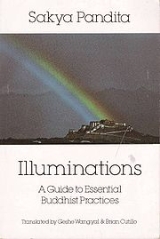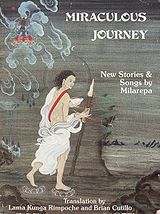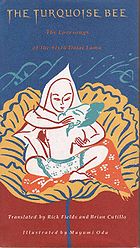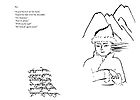
Brian Cutillo
Encyclopedia
Brian A. Cutillo was a scholar and translator in the field of Tibetan Buddhism
. He was
also an accomplished neuro-cognitive scientist, musician, anthropologist and textile weaver.
While at MIT, Brian wrote the music for An Evening of One Act Plays presented
October 14–15, 1966:
Brian provided the cultural background and translations for the recording "The
Music of Tibet". The recordings were made by Prof. Huston Smith
, then Professor
of Philosophy at MIT, in 1964. Dr. Smith provided an interpretation. The recording
was reviewed in the journal Ethnomusicology in 1972.
while a student at MIT. He became one of the
earliest American students of Geshe-La.
Geshe Wangyal wrote the book The Door of Liberation published by Maurice Girodias Associates, Inc., (1973) now out-of-print. (The book has been reissued in paperback Wisdom Publications). Among the Acknowledgments in the original edition are:
Geshe Wangyal and Brian Cutillo also translated the Illuminations of
Sakya Pandita published by (LOTSAWA 1988). The book is now out-of-print.
From the rear book cover:
Cutillo writes in the Preface to Illuminations:
poems translated with Lama Kunga Rimpoche. Drinking the Mountain Stream (First Edition LOTSAWA 1978) is
out-of-print (re-issue WISDOM Publications). Miraculous Journey (LOTSAWA 1986)
is out of print.
From the back cover of the First Edition of Drinking the Mountain Stream:
 From the back cover of Miraculous Journey:
From the back cover of Miraculous Journey:
From the Acknowledgments to Miraculous Journey: "We would like to thank Dr. Nathan Sivin for providing the rare xylograph edition of the Tibetan text." A similar note is mentioned in the First Edition of Drinking the Mountain Stream.
Lovesongs of the Sixth Dalai Lama (Tsangyang Gyatso). The book was published by HarperSanFrancisco
(HarperCollins 1994) and is out-of-print.
 From the back cover:
From the back cover:
From Whole Earth Review by Hacsi Horvath (Summer 1995)
Included are the poems:
The book page shows Ume calligraphy by Brian Cutillo and a drawing by Mayumi Oda.
Abhidharma
texts that remained
unpublished at his death.
Some of these translations are now being completed for publication under the
auspices, among others, of the Infinity Foundation. They were started some 35 years
ago in collaboration with Dr. Robert Thurman.
early days of the EEG Systems Lab in San Francisco. Cutillo co-authored
with Dr. Gevins, and others, numerous scientific research papers
including 3 papers published in Science, the Journal of the American
Association for the Advancement of Science. Along with a paper from the
EEG Systems Lab in Science in 1979, these 3 papers helped usher in the
modern era of cognitive neuroscience by reporting advanced computerized
methods of measuring the electrical signals in the human brain
reflecting fundamental cognitive processes of attention.
interplay between the Hopi
Indian community and Tibetan Buddhist monks who were
born in Tibetan speaking regions.
Cutillo's association with the Hopi community is documented in a radio recording
with James Koots A Hopi Plea. The recording is available from New Dimensions
Media as Program #1613. From the New Dimensions Website review:
based on early American heirloom patterns. Many of those weavings, including those in the photographs, are in private collections.
in the Tulare Advance-Register read:
Tibetan Buddhism
Tibetan Buddhism is the body of Buddhist religious doctrine and institutions characteristic of Tibet and certain regions of the Himalayas, including northern Nepal, Bhutan, and India . It is the state religion of Bhutan...
. He was
also an accomplished neuro-cognitive scientist, musician, anthropologist and textile weaver.
Studies at MIT
Cutillo was a graduate of MIT majoring in physics (1967).While at MIT, Brian wrote the music for An Evening of One Act Plays presented
October 14–15, 1966:
- At the Hawk’s Well -- By William Butler YeatsWilliam Butler YeatsWilliam Butler Yeats was an Irish poet and playwright, and one of the foremost figures of 20th century literature. A pillar of both the Irish and British literary establishments, in his later years he served as an Irish Senator for two terms...
; Directed by Ralph Sawyer ’67; Music - Brian Cutillo ’67
Brian provided the cultural background and translations for the recording "The
Music of Tibet". The recordings were made by Prof. Huston Smith
Huston Smith
Huston Cummings Smith is a religious studies scholar in the United States. His book The World's Religions remains a popular introduction to comparative religion.-Education:...
, then Professor
of Philosophy at MIT, in 1964. Dr. Smith provided an interpretation. The recording
was reviewed in the journal Ethnomusicology in 1972.
Studies with Geshe Wangyal
Brian Cutillo was introduced to Geshe WangyalGeshe Wangyal
Ngawang Wangyal , popularly known as "Geshe Wangyal," was a Buddhist priest and scholar of Kalmyk origin who was born in the Astrakhan province in southeast Russia sometime in 1901....
while a student at MIT. He became one of the
earliest American students of Geshe-La.
Geshe Wangyal wrote the book The Door of Liberation published by Maurice Girodias Associates, Inc., (1973) now out-of-print. (The book has been reissued in paperback Wisdom Publications). Among the Acknowledgments in the original edition are:
- "In connection with the Buddhist Studies Institute, I must acknowledge the efforts of two of my students, Dr. Christopher George and Dr. Robert ThurmanRobert ThurmanRobert Alexander Farrar Thurman is an influential and prolific American Buddhist writer and academic who has authored, edited or translated several books on Tibetan Buddhism. He is the Je Tsongkhapa Professor of Indo-Tibetan Buddhist Studies at Columbia University, holding the first endowed chair...
, who are now coordinating the activities of the Institute.
- "Also, I appreciate very much Dr. Jeffrey HopkinsJeffrey Hopkins (Tibetologist)Jeffrey Hopkins is a distinguished American Tibetologist. He is Emeritus of Tibetan and Buddhist Studies at the University of Virginia, where he taught for more than three decades since 1973...
' many years of dedicated service to the Lamaist Buddhist Monastery of America.
- "And last but not least, I extend my thanks to my students: to Brian Cutillo, for his devotion and effort in our work of translation ..."
Geshe Wangyal and Brian Cutillo also translated the Illuminations of
Sakya Pandita published by (LOTSAWA 1988). The book is now out-of-print.
From the rear book cover:
- "Like a blind man finding a jewel
- In a heap of garbage.
- Through what good fortune
- Was this Illumination born in me."
Cutillo writes in the Preface to Illuminations:
- "The work of translation began in 1970 with a reading of the text by the late Geshe Wangyal to close students at his retreat house in Washington, NJ...In the fall of 1985 I once again turned to the translation, but felt that the manner of presentation was too formal for its intended audience in America. Recalling Geshe Wangyal's exhortation to 'Do it PROPERLY'...
- "Illuminations attempts to (provide) a practical manual of essential Buddhist practices in a clear and direct style. This was also Sakya Pandita's purpose in the thirteenth century, and the book has been translated with his aim in mind."
Milarepa translations
Cutillo's best known work includes two books of MilarepaMilarepa
Jetsun Milarepa , is generally considered one of Tibet's most famous yogis and poets. He was a student of Marpa Lotsawa, and a major figure in the history of the Kagyu school of Tibetan Buddhism.- Life :...
poems translated with Lama Kunga Rimpoche. Drinking the Mountain Stream (First Edition LOTSAWA 1978) is
out-of-print (re-issue WISDOM Publications). Miraculous Journey (LOTSAWA 1986)
is out of print.
From the back cover of the First Edition of Drinking the Mountain Stream:
- "I the yogin Milarepa
- Begin meditation with fervent faith
- I saw without eyes the visible realm
- Heard without ears the sound of voidness,
- Smelled without nose the natural state's scent
- And tasted without tongue reality's sweet taste.
- An artist without hands
- Drawing pictures in the sky,
- Seeing without eyes the myriad things
- In perfect vision without movement or strain."

- "A rare collection of previously untranslated narratives and songs of the famous Tibetan poet-yogi Milarepa. This work is an untampered compilation of Milarepa's songs as preserved and sung by wandering yogis of the Kagyu sect. The pieces differ from those in the two popular volumes on Milarepa, the "Autobiography" and the "Hundred-Thousand Songs", in their range of material and directness of style, while continuing a high level of poetic expression. Thus they give a more candid glimpse of this famous yogi's personality than the more official versions.
- "This second volume of songs contains thirty-five new stories about the miraculous, wandering poet-saint of Tibet. From advice for local villagers and nomads to his most profound precepts given to his closest disciples, Milarepa informs and delights the reader with his insight, directness, and compassion..."
From the Acknowledgments to Miraculous Journey: "We would like to thank Dr. Nathan Sivin for providing the rare xylograph edition of the Tibetan text." A similar note is mentioned in the First Edition of Drinking the Mountain Stream.
The Turquoise Bee
With the late Rick Fields, Cutillo translated The Turquoise Bee. These were theLovesongs of the Sixth Dalai Lama (Tsangyang Gyatso). The book was published by HarperSanFrancisco
(HarperCollins 1994) and is out-of-print.

- "Deceptively simple and unadorned, the poems and love songs of Tibet's Sixth Dalai Lama (1683-1706) express the inner life of a legendary spiritual leader. Eloquently set in historical context, astutely translated, and beautifully illustrated, these sixty-seven poems articulate the mysteries, struggles, and joys of spiritual and sensual life with enduring reverence."
From Whole Earth Review by Hacsi Horvath (Summer 1995)
- "The Sixth Dalai Lama of eighteenth-century Tibet was a great tantric adept. He used to party all night in Lhasa's brothels and bars, then sneak back to the Potala palace before sunrise to perform his official duties. After a while the Sixth Dalai Lama even renounced his monastic vows and lived like a layman, getting drunk with his friends, singing songs and having fun, but maintaining his holy role as incarnation of Avalokitesvara, the Bodhisattva of Campassion. The Sixth Dalai Lama is still a beloved figure among Tibetans, not only for these anecdotes, but for his poems and spiritual teachings.
- "His songs are sparse and fresh. Rick Fields' and Brian Cutillo's translation is manly and true. Mayumi Oda's drawings are sublime."
Included are the poems:
- 33
- "A flower withers in a month's time.
- But the turquoise bee doesn't grieve.
- At the ending of an affair
- I will not grieve either."
- 64

- 65
- "I have asked so much
- of you
- In this short life.
- May we meet again
- In the childhod of the next."
The book page shows Ume calligraphy by Brian Cutillo and a drawing by Mayumi Oda.
Scholarly Tibetan Buddhism translations
Brian translated scholarly Tibetan BuddhismTibetan Buddhism
Tibetan Buddhism is the body of Buddhist religious doctrine and institutions characteristic of Tibet and certain regions of the Himalayas, including northern Nepal, Bhutan, and India . It is the state religion of Bhutan...
Abhidharma
Abhidharma
Abhidharma or Abhidhamma are ancient Buddhist texts which contain detailed scholastic and scientific reworkings of doctrinal material appearing in the Buddhist Sutras, according to schematic classifications...
texts that remained
unpublished at his death.
Some of these translations are now being completed for publication under the
auspices, among others, of the Infinity Foundation. They were started some 35 years
ago in collaboration with Dr. Robert Thurman.
- "...The following texts in rough draft form needing further work for publication in the mid-future: ... Abhidharma-samuccaya by Asanga (Thurman and Cutillo); Samdhinirmocana-sutra (Thurman and Cutillo) ..."
Research in human cognitive neuroscience
Brian Cutillo worked with his MIT classmate, Dr. Alan Gevins, in theearly days of the EEG Systems Lab in San Francisco. Cutillo co-authored
with Dr. Gevins, and others, numerous scientific research papers
including 3 papers published in Science, the Journal of the American
Association for the Advancement of Science. Along with a paper from the
EEG Systems Lab in Science in 1979, these 3 papers helped usher in the
modern era of cognitive neuroscience by reporting advanced computerized
methods of measuring the electrical signals in the human brain
reflecting fundamental cognitive processes of attention.
- Gevins, A.S., Morgan, N.H., Bressler, S.L., Cutillo, B.A., White, R.M., Illes, J., Greer, D.S., Doyle, J.C. & Zeitlin, G.M. (1987). Human neuroelectric patterns predict performance accuracy. Science, 235, 580-585.
- Gevins, A.S., Schaffer, R.E., Doyle, J.C., Cutillo, B.A., Tannehill, R.L. & Bressler, S.L. (1983). Shadows of thought: Shifting lateralization of human brain electrical patterns during brief visuomotor task. Science, 220, 97-99.
- Gevins, A.S., Doyle, J.C., Cutillo, B.A., Schaffer, R.E., Tannehill, R.S., Ghannam, J.H., Gilcrease, V.A. & Yeager, C.L. (1981). Electrical potentials in human brain during cognition: New method reveals dynamic patterns of correlation. Science, 213, 918-922.
With the Hopi community in Arizona
Cutillo was a key figure, initially as a Tibetan language translator, in theinterplay between the Hopi
Hopi
The Hopi are a federally recognized tribe of indigenous Native American people, who primarily live on the Hopi Reservation in northeastern Arizona. The Hopi area according to the 2000 census has a population of 6,946 people. Their Hopi language is one of the 30 of the Uto-Aztecan language...
Indian community and Tibetan Buddhist monks who were
born in Tibetan speaking regions.
Cutillo's association with the Hopi community is documented in a radio recording
with James Koots A Hopi Plea. The recording is available from New Dimensions
Media as Program #1613. From the New Dimensions Website review:
- "(James) Koots, designated messenger of the Hopi Elders, tells of the threat to the centuries-old tradition of the Hopi. Modern technology, unwanted government gifts and misdirected aid programs are taking their toll on the Hopi culture. In a personal and poignant way Koots shares the Hopi love of the Earth. He is joined by (Brian) Cutillo, a Buddhist scholar who has befriended the Hopi in their quest to preserve their ancient ways."
Textile endeavors
Brian Cutillo wove textiles on a manual floor loomLoom
A loom is a device used to weave cloth. The basic purpose of any loom is to hold the warp threads under tension to facilitate the interweaving of the weft threads...
based on early American heirloom patterns. Many of those weavings, including those in the photographs, are in private collections.
Obituary
Brian Cutillo died January 4, 2006 in Tulare, CA. His obituary (January 10, 2006)in the Tulare Advance-Register read:
- "Brian A. Cutillo, 60, of Tulare died Wednesday, Jan. 4, 2006. He was a scientist and an author. Funeral arrangements..."

